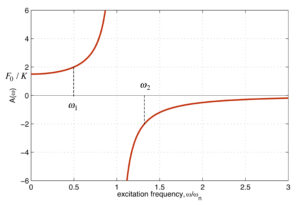Consider an undamped single degree-of-freedom system experiencing harmonic excitation whose equation of motion (EOM) is given by:

Here omegan is known as the natural frequency of response.
The particular solution for this EOM is give by:

where the magnitude of A is known as the "amplitude of response". A plot of A vs. omega the frequency of excitation omega is shown below.

Observations on A as a function of excitation frequency
For low frequencies of excitation (omega < omegan ), the response amplitude A is approximately F0/K, or the static response for a constant load of F0, as shown in the animation below. It is also seen that the response is "in phase" with the excitation (since A > 0).
| Frequency of excitation near zero The response is in phase with the excitation and the amplitude of response approaches the static response.  |
For near-resonant frequencies of excitation (omega approximately equal to omegan), the magnitude of A is large, as shown in the animation below. It can be shown that the response is "90 degrees out of phase" with the excitation.
| Frequency of excitation near resonance The response is nearly 90 degrees out of phase with the excitation and the amplitude of response is large.
|
For high frequencies of excitation (omega > omegan ), the magnitrude of the response amplitude A is very small, as shown in the animation below. It is also seen that the response is "180 degrees out of phase" with the excitation (since A < 0).
| Large frequency of excitation The response is 180 degrees out of phase with the excitation and the amplitude of response is small.  |
